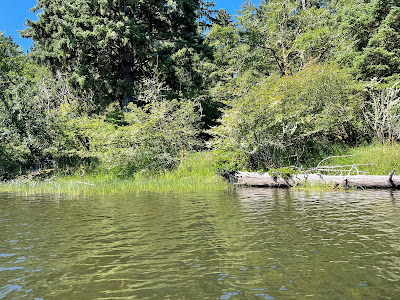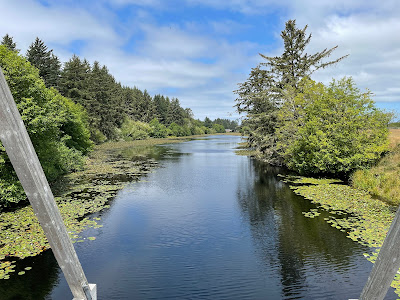Lots of kids running around. Check that, lots of kids riding around. Paige says she has memories of going on family trips to camps like this and the kids were allowed to ‘ride the loop’ all by themselves. That is what is happening here. Gangs of kids riding around the loop (often in the wrong direction) pretty much ignoring the car and truck traffic. When you are driving you just have to come to a stop until they pass you because there is no telling what they are going to do. And they give you funny looks like “what are you doing driving in the road, mister?”. Paige says I am practicing my grumpy old man act. Who needs practice?
 |
| Lots of this octagonal net tents around |
 |
| Is this really the only vehicle picture that I took? |
And what are they riding? There seems to be a profusion of new personal vehicles available of late. Especially new e-vehicles. Bikes, of course; all sizes. Many of them either electric assist or full electric. A few electric long skateboards, being ridden by two at a time. Seems like there are 5 identical little girls on tiny pink bikes with tiny pink training wheels. Maybe it is the same girl and she is just riding round and round the loop. There is a thing that looks like 2 scooters glued together with on upright handlebar. The bottom parts make a V and you put a foot on each of the legs and sort of skate back and forth to go forward. Seems to work just fine. Saw some adults in electric recumbent tricycles. They were blocking traffic because they were sort of the in the bike lane but they were really too wide to pass and they couldn’t decide which laws they were following, car or bike. And it does seem like all of the adults are riding some kind of eBike. Some have the ones like I do, where you just get a little assist when you peddle (but you have to peddle). Others have the big huge heavy ones with the big wheels that you can just crank up the throttle and go. I saw one couple ride by on ones where they had given up the entire “this is a bike” thing and they had no pedals. I guess they were small electric motor scooters.
All of these new electric vehicles, including one zooming down the street with bright lights that was the one wheel kind that you stand on and lean forward. The thing you don’t see is the original vehicles of this ilk, the Segway. They just never caught on. I suspect that they were too expensive and maybe just so ahead of their time that people didn’t believe they were useful. They were quite a bit larger and more expensive than any of the vehicles we see zooming around at the park.
And this is all so new. I don’t think you would have seen so many different eVehicles at a state park even 5 years ago. The eBike makers must be making a bundle.
The people in the campsite next to our just came over and introduced themselves and offered me a ice-cream bar. So nice of them. And it was delicious. Some sort of coconut and cream bar. They are Spanish speakers, so I wonder if it is some treat from Mexico (oh, they just stopped by again and I saw the box, from Mexico). There are also a lot of people speaking some Slavic language, perhaps Russian. There is a large Slavic Church group here (they have a huge passenger bus). Paige talked to some of the people in the group and they said that some of the larger churches will reserve an entire loop for a week for their family camps. Wow. We got in here on a last minute cancellation, so perhaps one of the churches had released a few sites.
Wait, that can’t be true, I know that the oil rigs north of Santa Barbara were shelled. Something in Southern Oregon was also shelled, or maybe that was a fire balloon. Still, attacked. I need to research this. Once again, I will have to wait until I have internet. The area we are camping in is very nice but it doesn’t have enough cell phone signal to do anything. Not sure what good telling me I have 1 bar if you can’t actually do anything with 1 bar. Might as well be 0 bars, you know what I mean? Internet says that Fort Stevens was the First mainland military base to be attacked by the Japanese. They fired 17 shells and took out the camps baseball field backstop. You know what else I found? There are 2 Forts named Fort Stevens. One is near Washington DC. They are both now National Parks and are both named after the same guy.
Old historic forts like this are kind of funny. I mean, they are not doing anything to restore or maintain most of the fortifications. They cut the grass and put up fences when things get too dangerous. I guess they are interesting to see, but they can’t last too long except as rusted out hulks unless they are repaired. And the most interesting things about them, the guns, are long gone. Well, there are a few left but most of the biggest ones (like from the late 1800’s) were scrapped a long time ago.
A great thing about the major bike paths in this park is that they do not follow the roads. They go to the same places (generally) that the roads go to, but they go through the woods, follow old canals, or go down the dune lines usually quite distant from the car traffic. They are very scenic bike paths, lots of view of lowland marshes and big Sitka trees. Just be careful to stay on your side because when you round that corner ahead, one of those huge big wheel eBikes could be barreling your way and those puppies are too heavy to dodge well. (Good thing I was on a light 18 speed and I could do the dodging).
Every campground should probably get a bug report. Oregon is pretty blessed with a low bug population (at least on the west side of the Cascades). Here near the mouth of the Columbia I am happy to report very few mosquitos (say, you kill 2 a night), even fewer biting flies (1 in 2 days) and not that many red midges (3 or 4, and I don’t think they were the biting kind). One strange thing did happen to me. As I was riding my bike home from the old Military base my ankle suddenly hurt. It felt like I had twisted it. I was riding my bike quickly down the smooth paved path so hard to see how that possibly could have happened. So I ignored it. When I got back to camp, it still hurt. It hurt to touch and it hurt a little to walk. So I pulled off my shoe and sock and examined it. There was a suspicious red spot there, about the size of a Nickel. In addition, my ankle was starting to swell some. I don’t know what did it, but something either stung or bit me. Something that doesn’t feel like any traditional bee or wasp sting that I have had. Later on (after a couple of hours) the pain started to feel less like a sprain and more like a sting (or like a burn). This morning (12 hours later) it still hurts on occasion but it really itches. I wonder what tagged me? (Update, that puppy itched for nearly 2 weeks)
Last night I walked around our little loop area at camp. The family camps had all gathered together in groups of 10 to 15 around roaring campfires and were having social times. One group was telling stores (perhaps ghost stories). The group just a couple sites down from us had out a guitar and a couple were singing some what I imagine were folk songs. They were in some Slavic language and the people were singing harmony parts. In many parts of the songs most of the people in the circle would join in. It sounded pretty good but I did not recognize the tune or the words.
The other big difference about the being over here amongst the large family (church?) groups is that there are no big RV’s. in the other loops there are all of the Mega RV’s parked next to each other, over hear it is all tents and pop-ups. Our little SCAMP is the largest RV in this section of the loop.
 |
| Walkway out at the tip. |
 |
| A freighter on the Columbia |
 |
| The Jetty |
One Day we hiked the Fort to the Sea Trail. See Here.
One day we went to the beach to go boogie boarding but we decided it was too cold so we just lounged by ourselves in the sand and sun on an empty beach.






























